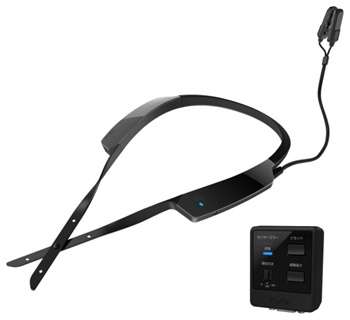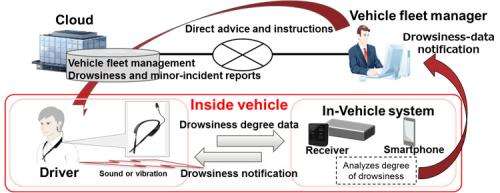Wearable sensor promotes safer driving

Fujitsu today announced the launch of Fujitsu Vehicle ICT FEELythm, a new wearable sensor product that promotes safer driving. Intended for use in the transportation sector, FEELythm will initially be sold in Japan from February 2015.
FEELythm is a wearable sensor device that detects when drivers are drowsy based on their pulse. The product, which uses a proprietary algorithm developed by Fujitsu Laboratories, monitors the driver's pulse via a sensor attached to the earlobe, gauges drowsiness based on that, and notifies the driver and their vehicle fleet manager. It can also connect to digital tachographs and other onboard devices, and link to fleet-management systems so that fleet managers can monitor the conditions of their drivers in real time and provide helpful guidance based on objective data.
In the near future, it will be possible to improve safe-driving management by predicting dangers before they occur based on an accumulation of sensor data indicating fatigue, stress, and tension, and applying that to a hazard map. Human error not attributable to driving violations or skill has accounted for approximately 67% of all traffic accidents in recent years. Legal reforms and support for devices that promote safe driving from the Ministry of Land, Infrastructure, and Transport are aimed at improving this situation.
Given this background, Fujitsu developed FEELythm for fleet vehicle operations such as buses, trucks, and taxis, to be usable in a variety of businesses and environments.
Product Features
- Comfortable to use, and designed for long-haul driving In the interest of comfort, the main part of the device is worn around the neck and weighs only about 90 grams, and a sensor is attached to the earlobe to measure vital signs such as pulse rate and the autonomic nervous system. Fujitsu's proprietary algorithm determines the driver's level of drowsiness with a high degree of accuracy, and the device gives sound and vibration alerts to the driver. The device was designed with long-haul driving in mind, with battery capacity for five continuous days of operation.
- Learning function eliminates individual variability while improving accuracy Automatic calibration and a learning function adapt to the ranges of readings in vital signs that will vary from person to person and detect drowsiness more accurately.
- An effective system to give drivers safe-driving guidance Connecting these devices to a fleet-management system lets managers monitor detection data and gives them objective data to help them strengthen their safety management.
Moving forward, Fujitsu will put to use hazard maps that compile and distill driver data and stress conditions in order to bring hazard prediction to fleet operations and expand support for driving-safety management.

Provided by Fujitsu





















